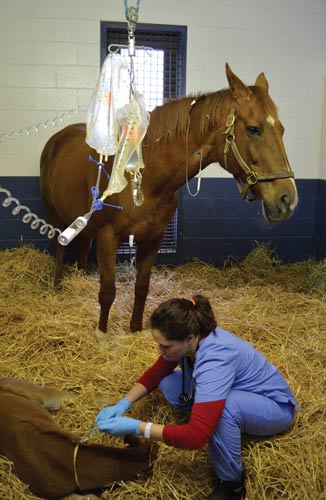Large animal practitioners grapple with fluid shortage
Dr. Stuart E. Brown II might not have any 5-L bags of sterile fluids left to treat his equine patients.
At press time in March, Dr. Brown was among the large animal practitioners across the country grappling with a shortage of large-volume polyionic fluids—separate from the ongoing shortage of normal saline solution.

The problem started last fall and became critical by winter. The AVMA has been collaborating with the American Association of Equine Practitioners plus the AVMA PLIT, the Trust that provides professional liability insurance for veterinarians, to come up with short- and long-term fixes.
“The lack of availability of these products is impacting veterinarians’ ability to provide care for their patients,” according to a January letter from the AVMA to the Food and Drug Administration.
In response, the FDA announced in February that it is working to address the lack of both 3-L and 5-L bags of fluids for intravenous administration in large animals. According to the announcement, “The shortage has been triggered by a range of factors, including increased demand combined with a reduction in the manufacturing of sizes most suitable for use in large animals.”
The FDA is allowing Sypharma Pty. Ltd. of Australia to distribute Hartmann’s solution in the United States temporarily to mitigate the shortage. The agency advised veterinarians to contact Sypharma directly at info sypharma [dot] com [dot] au (info[at]sypharma[dot]com[dot]au) for information on obtaining the product.
sypharma [dot] com [dot] au (info[at]sypharma[dot]com[dot]au) for information on obtaining the product.
“Preventing drug shortages is a top priority for the FDA,” spokesperson Megan Bensette said. “While FDA cannot require a manufacturer to produce a product, the agency will continue to work with industry to improve access and alleviate this shortage.”
Also in February, the AVMA and AAEP sent a letter to Zoetis requesting that the company work with a supplier to manufacture 5-L bags of sterile fluids for intravenous administration in horses and other large animals.
According to the letter: “In equine referral hospitals during just a moderately busy week, it is commonplace to use more than 1,000 liters of sterile fluids per week. Use of one-liter bags is unmanageable in equine medicine. A single horse with colic or other intensive medical conditions can require 40-100 liters, or more, per day. The compounding of intravenous-use fluids as an alternative has both animal-health risks and legal risks. Simply put, equine veterinarians are in critical need of large-volume, manufactured sterile fluids to provide optimal patient care.”
In March, Zoetis announced that it is “actively and urgently seeking to secure product with registered suppliers.”
According to a statement from Zoetis to AAEP members, there has been a multiyear history of global supply challenges in fluids for intravenous administration. According to the statement, “With our acquisition of the fluids business from Abbott Animal Health in February 2015, we have begun to evaluate this segment in greater detail and we are evaluating all supply options.”
Per Zoetis, the supply challenges are primarily the result of changes in the regulatory oversight of fluids manufactured for intravenous administration in humans.
“The former Abbott Animal Health fluids had the distinction of being the only products labeled specifically for veterinary use,” according to the statement. “It is our current understanding that supply for all providers continues to be difficult and frequently disrupted.”
Dr. Brown sees the situation from several angles. He is a partner at Hagyard Equine Medical Institute in Lexington, Kentucky, as well as a member of the AAEP board of directors and a member of the AVMA PLIT board of trustees.
In February, Hagyard was at the height of its busy season with foaling mares and neonatal foals. Dr. Brown can treat foals by using 1-L bags of fluids, but the smaller bags are cumbersome for fluid therapy in mares. For fluid therapy in adult horses, he can put together four 5-L bags on a fluid administration set, but not 20 1-L bags. Hagyard has investigated various options such as finding fluid administration sets that can accommodate 20 1-L bags, repackaging 1-L bags, or even preparing fluids.
“We are very, very concerned about the health of our patients,” Dr. Brown said. At the same time, he has concerns about the concentration and sterility of homemade fluids and about the sterility of repackaged fluids.
If large animal practitioners do have to resort to repackaging or preparing fluids in certain scenarios, Dr. Brown said, it would be advisable whenever possible to have a conversation to gain owner consent before administering the fluids.
Dr. Brown realizes companies have to analyze the costs and benefits of manufacturing products for a niche market. Nevertheless, he said, “Having the commercially available products that give us confidence that we’re delivering a high-quality intravenous fluid that is sterile and nonpyrogenic is really crucial to delivery of the standard of care that most of our clientele have come to expect.”
Related JAVMA content:
Shortage of saline solution continues for months (Aug. 1, 2014)
FDA warns of nonsterile saline solution bags (March 15, 2015)
On back order: Drug shortages seem to be increasing in veterinary medicine (Nov. 15, 2010)